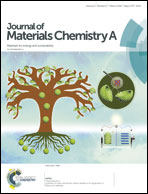Extracting maximum capacity from Ni-rich Li[Ni0.95Co0.025Mn0.025]O2 cathodes for high-energy-density lithium-ion batteries†
Abstract
The electrochemical properties of Li[Ni0.95Co0.025Mn0.025]O2, the composition of which is similar to that of LiNiO2, were evaluated to test whether the beneficial effect of Co and Mn addition persists at this extremely Ni-rich layered Li[NixCoyMn1−x−y]O2 (NCM) cathode. Despite their low concentrations, the presence of Co and Mn ions notably improved the cycling and thermal stability of Li[Ni0.95Co0.025Mn0.025]O2 over that of LiNiO2 (initial discharge capacity of 238 mA h g−1 with 85% retention after 100 cycles when cycled at 4.3 V for Li[Ni0.95Co0.025Mn0.025]O2vs. 248 mA h g−1 but with 74% retention for LiNiO2). It was also shown that the capacity degradation of highly Ni-enriched NCM cathodes appears to arise from the anisotropic volume change during Li removal/insertion, which was aggravated by the formation of the H3 phase in the delithiated state. The particle core was especially susceptible to structural damage from the accumulation of the intrinsic internal strain, which led to the initiation and propagation of microcracks from the particle core. The microcracks subsequently exposed the particle core to electrolyte damage for a prolonged period in the delithiated state, leading to eventual disintegration of the secondary particles. It appears that protecting the particle core (or interparticle boundaries) may help in extending the cycling stability of Ni-rich NCM cathodes, especially for those with very high Ni compositions.
![Graphical abstract: Extracting maximum capacity from Ni-rich Li[Ni0.95Co0.025Mn0.025]O2 cathodes for high-energy-density lithium-ion batteries](/en/Image/Get?imageInfo.ImageType=GA&imageInfo.ImageIdentifier.ManuscriptID=C7TA11346C&imageInfo.ImageIdentifier.Year=2018)


 Please wait while we load your content...
Please wait while we load your content...